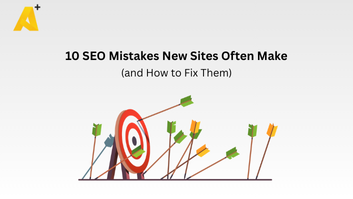Launching a new website is exciting but without proper SEO, even the best-looking sites get buried in search results. If you’re not getting the traffic you expected, it’s likely due to some common SEO mistakes that many new website owners make.
Here’s a breakdown of the top 10 SEO mistakes for new websites and how you can fix them before they hurt your rankings.
1. No Keyword Strategy
Mistake:
Many new site owners publish content without a clear keyword strategy, hoping that search engines will find and rank their pages automatically. Without targeting specific search queries, your content may never reach the right audience.
Fix:
Start by conducting keyword research using tools like Google Keyword Planner or Ubersuggest. Identify keywords that are relevant to your niche, have low to medium competition, and align with what your target audience is searching for. Build content around these terms and integrate them naturally into titles, headers, and body content.
2. Poor Site Structure
Mistake:
A cluttered or confusing website layout makes it difficult for users to navigate and for search engines to crawl and index your pages. Sites without a logical hierarchy often frustrate visitors, increasing bounce rates.
Fix:
Design your website with a clear hierarchy: home > categories > subcategories > individual pages. Use descriptive navigation menus, breadcrumb links, and organize content into meaningful sections. Internal linking between related pages also helps improve crawlability and user experience.
3. Missing Meta Titles and Descriptions
Mistake:
Neglecting to add custom meta titles and descriptions for each page is a missed opportunity for improving search visibility and click-through rates. These tags are often what users see in search engine results.
Fix:
Write unique, keyword-rich meta titles and descriptions for every page. Keep titles under 60 characters and descriptions under 160. Include your target keyword and a compelling reason for users to click (e.g., “Learn,” “Discover,” “Get a Free Quote”).
4. Ignoring Mobile Optimization
Mistake:
Websites that are only designed for desktops often break or display poorly on mobile devices — leading to bad user experience and lower search rankings, as Google prioritizes mobile-first indexing.
Fix:
Use responsive design to ensure your site adapts to all screen sizes. Test your site using tools like Google’s Mobile-Friendly Test to identify and fix usability issues on smartphones and tablets.
5. Slow Page Load Times
Mistake:
A slow-loading website leads to higher bounce rates and negatively impacts your SEO performance. Causes may include uncompressed images, excessive scripts, or low-quality hosting.
Fix:
Compress image files, enable browser caching, and use performance-enhancing plugins or CDNs (Content Delivery Networks). Choose a reputable web hosting provider known for speed and reliability. Tools like PageSpeed Insights can help diagnose specific issues.

6. No XML Sitemap
Mistake:
Without an XML sitemap, search engines may have trouble discovering and indexing all the pages on your website — especially if it’s new or has complex navigation.
Fix:
Generate an XML sitemap using platforms like Yoast SEO (for WordPress) or third-party tools. Submit your sitemap to Google Search Console and Bing Webmaster Tools. This ensures that search engines can efficiently crawl and index your site.
7. Thin or Duplicate Content
Mistake:
Pages with little original content or duplicate text from other sources can lead to poor rankings. Google rewards useful, unique content that provides real value to users.
Fix:
Create in-depth, high-quality content tailored to your audience’s needs and interests. Avoid copying text across multiple pages. Use canonical tags when duplicate content is unavoidable (e.g., product pages with slight variations).
8. Not Using Header Tags Properly
Mistake:
Failing to use header tags (H1, H2, H3, etc.) correctly can confuse both users and search engines about your page’s structure. Some pages have no headers; others overuse them without logical order.
Fix:
Use a single H1 tag for the main page title. Structure subheadings with H2 tags, and use H3 or H4 for further breakdowns. This not only improves readability but also helps search engines understand content relevance and hierarchy.
9. Ignoring Local SEO
Mistake:
For service-based or location-specific businesses, ignoring local SEO means missing out on nearby customers actively searching for what you offer.
Fix:
Set up and optimize your Google Business Profile with accurate business information, hours, and photos. Use location-based keywords (e.g., “web development in New York”) and build local citations on directories like Yelp, Bing Places, and industry-specific listings.
10. No Analytics or Tracking
Mistake:
Without tools to track performance, you’re essentially flying blind — unable to see what content works, where traffic comes from, or how users behave on your site.
Fix:
Install Google Analytics and Google Search Console as soon as your site goes live. These tools help you monitor traffic sources, bounce rates, keyword rankings, and more — allowing you to refine your SEO strategy over time.
Final Thoughts
In search engine optimization (SEO), position is not the only thing that matters; visibility, trust, and user experience are all important. You may put your website on the road to long-term success and sustained development by avoiding these typical rookie mistakes that are made in search engine optimization.
We at Aplus Tech Solutions assist businesses in the development of search engine optimized platforms that generate traffic and results, in addition to creating visually appealing websites.
